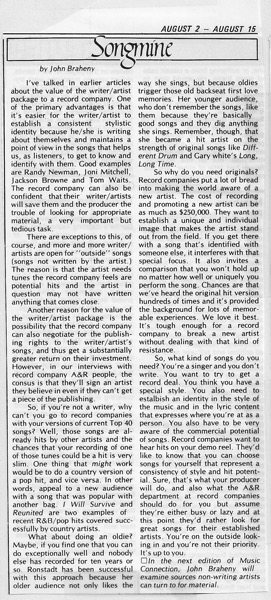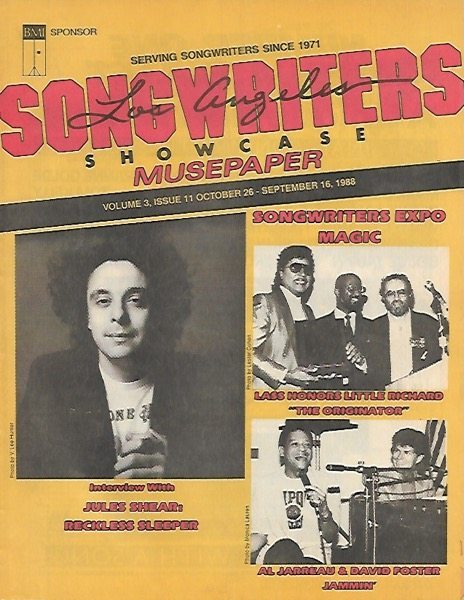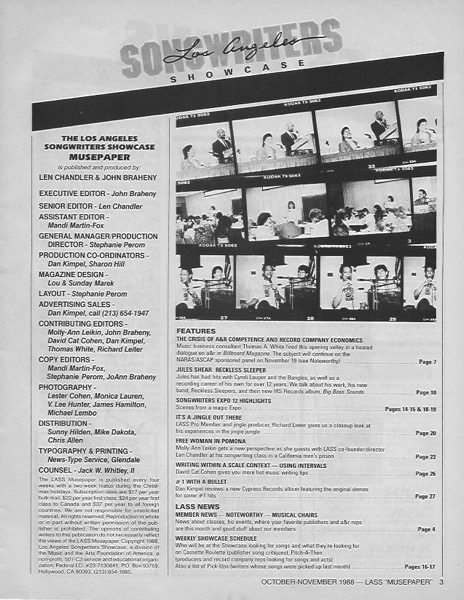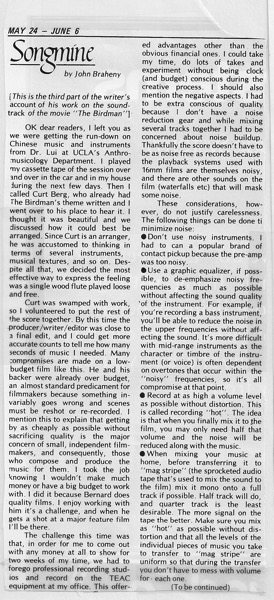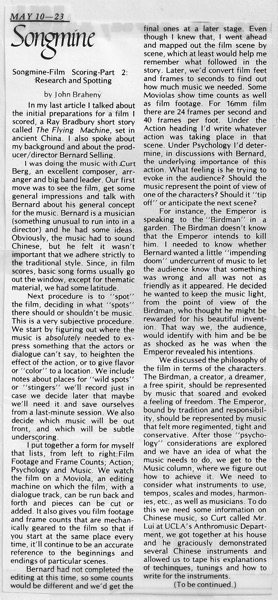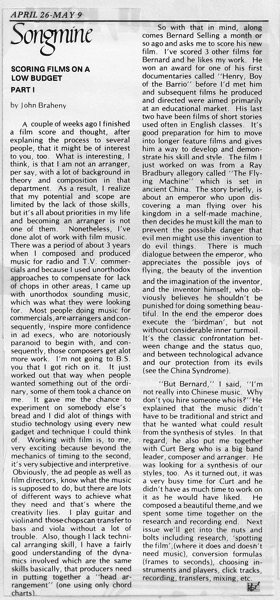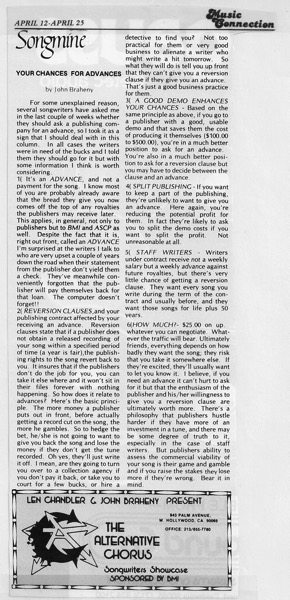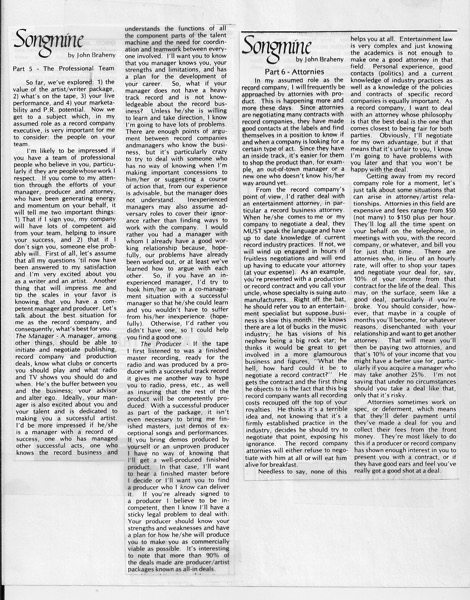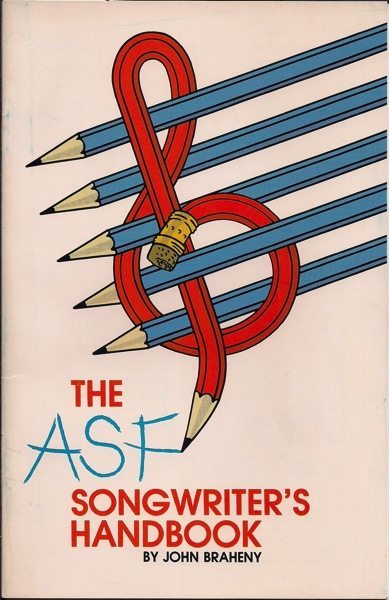A John Braheny Songmine column from the archives…
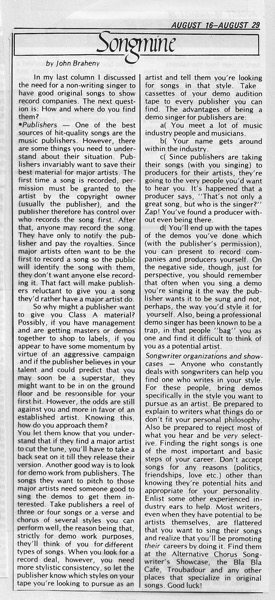
Accession Number: C000000137-021-002 Document/Digital File, “Songmine: For the non-writing artist: Where do you find original material by John Braheny”, OCR converted text under same Accession Number
(Digitally converted text. Some errors may occur)
AUGUST 16—AUGUST 29
Songmine by John Braheny
In my last column I discussed the need for a non-writing singer to have good original songs to show record companies. The next quest-ion is: How and where do you find them?
•Publishers — One of the best sources of hit-quality songs are the music publishers. However, there are some things you need to under-stand about their situation. Pub-lishers invariably want to save their best material for major artists. The first time a song is recorded, per-mission must be granted to the artist by the copyright owner (usually the publisher), and the publisher therefore has control over who records the song first. After that, anyone may record the song. They have only to notify the pub-lisher and pay the royalties. Since major artists often want to be the first to record a song so the public will identify the song with them, they don’t want anyone else record-ing it. That fact will make publish-ers reluctant to give you a song they’d rather have a major artist do.
So why might a publisher want to give you Class A material? Possibly, if you have management and are getting masters or demos. together to shop to labels, if you appear to have some momentum by virtue of an aggressive campaign and if the publisher believes in your talent and could predict that you may soon be a superstar, they might want to be in on the ground floor and be resuonsible for your first hit. However, the odds are still against you and more in favor of an established artist. Knowing this, how do you approach them? You let them know that you under-stand that if they find a major artist to cut the tune, you’ll have to take a back seat on it till they release their version. Another good way is to look for demo work from publishers. The songs they want to pitch to those major artists need someone good to sing the demos to get them in-terested. Take publishers a reel of three or four songs or a verse and chorus of several styles you can perform well, the reason being that, strictly for demo work purposes, they’ll think of you for different types of songs. When you look for a record deal, however, you need more stylistic consistency, so let the publisher know which styles on your tape you’re looking to pursue as an
artist and tell them you’re looking for songs in that style. Take cassettes of your demo audition tape to every publisher you can find. The advantages of being a demo singer for publishers are:
a( You meet a lot of music industry people and musicians.
b( Your name gets around within the industry.
c( Since publishers are taking their songs (with you singing) to producers for their artists, they’re going to the very people you’d want to hear you. It’s happened that a producer says, “That’s not only a great song, but who is the singer?” Zap! You’ve found a producer with-out even being there.
d( You’ll end up with the tapes of the demos you’ve done which (with the publisher’s permission), you can present to record com-panies and producers yourself. On the negative side, though, just for perspective, you should remember that often when you sing a demo you’re singing it the way the pub-lisher wants it to be sung and not, perhaps, the way you’d style it for yourself. Also, being a professional demo singer has been known to be a trap, in that people “bag” you as one and find it difficult to think of you as a potential artist.
Songwriter organizations and show-cases — Anyone who constantly deals with songwriters can help you find one who writes in your style. For these people, bring demos specifically in the style you want to pursue as an artist. Be prepared to explain to writers what things do or don’t fit your personal philosophy. Also be prepared to reject most of what you hear and be very select-ive. Finding the right songs is one of the most important and basic steps of your career. Don’t accept songs for any reasons (politics, friendships, love etc.) other than knowing they’re potential hits and appropriate for your personality. Enlist some other experienced in-dustry ears to help. Most writers, even when they have potential to be artists themselves, are flattered that you want to sing their songs and realize that you’ll be promoting their careers by doing it. Find them at the Alternative Chorus Song-writer’s Showcase, the Bla Bla Cafe, Troubadour and any other places that specialize in original songs. Good luck!
Previously in the Songmine Collection:
- Songmine: For the non-writing artist: Why you need original material by John Braheny
- Songmine: Scoring Films on a Low Budget Part 6 by John Braheny
- Scoring Films on a Low Budget Part 5 by John Braheny
- Songmine: Scoring Films on a Low Budget Part 4 by John Braheny
- Songmine: Scoring Films on a Low Budget Part 3 by John Braheny
- Songmine: Scoring Films on a Low Budget Part 2: Research and Spotting
- Songmine: Scoring Films on a Low Budget Part 1
- Songmine: The Chances for Advances by John Braheny
- Songmine: What a Record Company Needs to Know – Part 6: Attorneys by John Braheny
- Songmine: What a Record Company Needs to Know – Part 5: The Professional Team by John Braheny
- Songmine: What a Record Company Needs to Know – Part 4: What Makes This Act Marketable? by John Braheny
- Songmine: What A Record Company Needs to Know : Part 3
- Songmine: What A Record Company Needs to Know: Part 2 by John Braheny
- Songmine: What A Record Company Needs to Know: Part 1 by John Braheny
- Songmine: Getting the Most from the Trades Part 4
- Songmine: Getting the Most from the Trades Part 3 by John Braheny
- Getting the Most from the Trades
- Songmine: Publishing III
- Songmine: Leave Your Ego at the Door
- Songmine: “Feedback: Why some publishers won’t give it”
- Songmine: Dealing with Rejection by John Braheny
- “Music in Print” – A Songmine Column from Music Connection Magazine March 19-April 1, 1981
About Songmine and Music Connection Magazine:
John Braheny met Eric Bettelli and Michael Dolan right before they were going to publish Music Connection magazine. Eric and Michael wanted to get their publication out to as many songwriters as they could. They had already heard of the LA Songwriters Showcase, and of John and his partner, Len Chandler. John’s goal was to advertise the schedule of guest speakers and performers at the weekly Showcase… so they made a deal.
They published John’s Songmine column (he had never before written a magazine article!) in their very first edition, in November 1977. Trading out the column for advertising, this arrangement continued for many years. Plus, Eric and Michael came to the Showcase each week and distributed free copies to the songwriters!
Those articles became so popular that (book agent and editor) Ronny Schiff offered John’s articles to F&W Media, where they became the backbone of John’s textbook, The Craft and Business of Songwriting. As a follow-up, Dan Kimpel (author, songwriter, teacher), who had also worked at LASS, took on the Songwriting column at Music Connection magazine which continues to this day! You can subscribe to get either hard copies or online.
